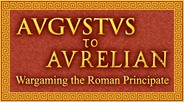Over the holiday, I played a few small playtest games of the new rules (using some 1/4 scale 'counters' I made to represent the units), and we (Anna and I) have continued this during this week - but using figures now we're at home - and playing rather bigger games. I'm pleased to report that the movement, shooting, combat and morale rules all now work pretty well, and are probably near enough ready for some 'external' play-testing. But the test games did reveal all sorts of problems with the card-driven turn sequence system, which is closely linked to the command and control system. The way it was working was too complex, somewhat slow, but worst of all, didn't achieve what I wanted - i.e. a dynamic battle in which the commanders had limited but nonetheless vital contributions to make. Instead it played rather like most other wargames, with the player having too much control over his army.
Some of the problem was clearly due to the systems being poor, but some was down to poor selection of cards for the deck. The number, and type, of cards is really quite critical to how the game plays, and I guess that it'll take practice to get good at picking a deck which gives a satisfying game. But if it didn't take effort, it probably wouldn't be as satisfying in the long run.
These problems caused a day or two of soul-searching, and some hard thinking. I've since re-written the whole turn sequence and C&C section, and am letting it 'mature' a bit before re-reading it to see if I still think the changes are okay. After that, if I'm still happy, we'll play-test it. The wording is a little crude and over-complicated, but I think the revised systems will work - I'll tweak the wording later to make it easier to follow. I've also added the section on orders, without which the C&C and turn sequence don't make much sense - the absence of which, looking back, were a large part of the cause of my dissatisfaction with the most recent play-test.
I'm fairly confident that we'll have a version which works well enough ready for a big game at Partizan in September. And then, perhaps, we'll be ready to let some of you have copies to play-test. There's still a long way to go though - not least in terms of 'army lists' - we need to work out unit statistic profiles for all the armies the Romans came up against during the three hundred years or so of the Principate. I can handle the various flavours of Romans, Gallic and British Celts, plus Parthians, Palmyrenes and Sassanid Persians, but then my narrow focus begins to let me down. I know a bit about the Germans, Dacians, Sarmatians and Jews, but what about Armenians, Illyrians, Astures, Goths, Vandals and others?
Having mentioned 'Army Lists' I ought to point out that these will just be a bit of 'potted history' to give some flavour, plus a list of troop-types and their profiles. I am definitely not intending to provide a points system, nor am I going to be dictating the make-up of forces - you'll have to do your own research for that! This game is in no way intended for 'equal points' gaming. Points are always arbitrary anyway - witness how each set of ancients rules has its own 'killer army' - that's really down to the inexactitudes of any points system - they can't cope with the multiple variables involved in trying to model ancient warfare. And I don't want to encourage 'competition wargaming'; I particularly don't want the competition gamers to use the rules and start demanding changes to fill perceived 'loopholes'. That way, in my experience, lie only dissatisfaction, frustration, and the ruin of an enjoyable game for the majority of gamers who just want to push some well-painted lead around an attractive wargames table to relax with their mates.
